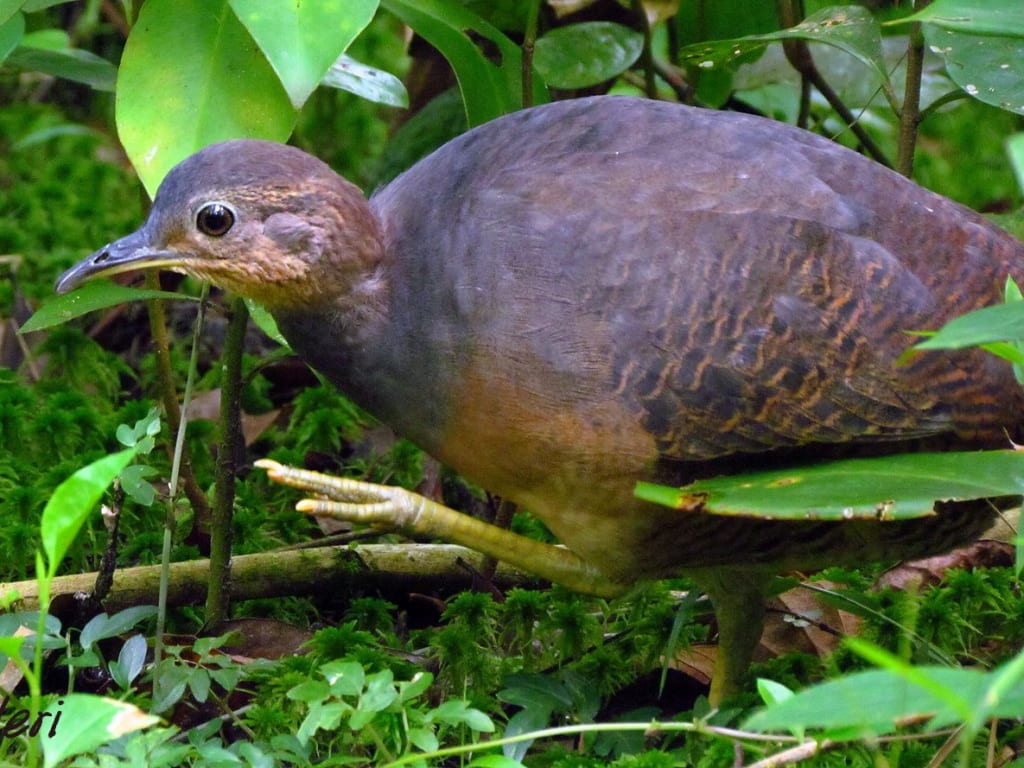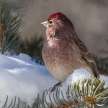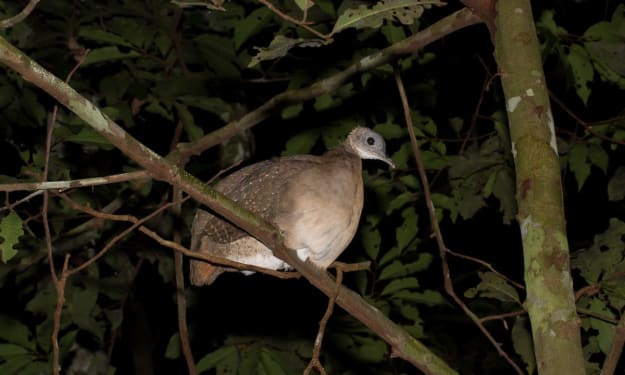
The yellow-legged tinamou (Crypturellus noctivagus) is a species of tinamou that grows in both tropical and subtropical, wooded and shrubby habitats in eastern Brazil. The superficially quail-like bird has a grey-brown plumage, with two clearly identifiable subspecies. This has declined due to human activities, and is now listed as Near Endangered by the IUCN. The yellow-legged tinamou is about 28-31 cm tall. Her upper parts are white, her lower back is black-barred, her chest and upper breast are greyish, her lower breast is rufous and her belly is pink. It has a blackish bonnet and a tray with a supercilium. The supercilium in the race zabele, which in general is also more paler, has a whiter (less rufescent) throat and lighter yellow legs than the so-called breed, is broadest and most conspicuous. The yellow-legged tinamou, like other tinamous or low-lying species, takes fruit from the ground. They also consume small amounts of invertebrates, blossoms, delicate herbs, seeds, and roots. The male incubates the eggs that can come from as many as four different females, then leaves them up until they can be free, normally 2–3 weeks. On the field the nest is in dense brush, or between high root buttresses. The natural habitat is tropical forest, but in drier wooded areas such as savanna-woodland and Caatinga the zabele subspecies also occur. It may be situated at an altitude of 700 m or less. The yellow legged tinamou suffers from severe and persistent habitat destruction and hunting competition. Overall, though their numbers decrease, they are not critical and are not listed as Near Threatened by IUCN. It has an incidence area of 1,470,000 sq km. There are no current records from regions of the scope, and Rio de Janeiro seems to have erased them. Yellow legged Tinamou is a very common Brazilian species found in woodland environments, savanna forests and forests of galleries. This tinamou is primarily limited to the littoral in the south of its range, though it also occurs in the interior farther north. The species occurs from southern Piauí and eastern Pernambuco south to Rio Grande do Sul, but the Yellow-legged Tinamou is now increasingly scarce particularly in the northern part of this area, and forest clearance has led to declines in its population virtually across eastern Brazil. His song, which can be heard almost day-long during the breeding season (probably the southern spring, at least in the southern part of the range), is a slowly produced and rather mournful two- or four-noted a-ooooooo or a-oooooo, to some degree reminiscent of that of the partially sympatric Tinamou (Tinamus solitarius). The species is often seen in small groups, and some researchers have proposed that the males can gather at leks, but this is still unconfirmed. The Yellow-legged Tinamou (Crypturellus noctivagus) is an endangered coastal woodland bird of Brazil. Crypturellus noctivagus noctivagus subspecies females and males are distinct in the naked eye, although there is a lack of details about how to distinguish between the sexes in the region. We spoke about the morphometric differences between genders C. n. Noctivagus to decide what measures should be undertaken to identify gender. Sex differentiation in individuals (four females and seven males) was accomplished through molecular science. Differences between the sexes were measured through the Student's t and Mann-Whitney analyses and a Principal factor analysis. On average, females were 9.9 pounds overweight, and had 11.8 pounds more bills than males. Males had middle toes 8.7 percent longer and 19.0 percent longer than females, the latter suggesting the largest degree of dimorphism of all measurements. Our results suggest that morphometric variables that are used in cases where molecular sexing is not feasible to determine the sex of C. n. Men on Noctivagus.
About the Creator
MB
I am a bird aficionado and really enjoy spotting them them on hikes. I greatly appreciate the variety of birds cross North America and the world. They are amazing and intelligent creatures, each so unique and with a wonderful life.






Comments
There are no comments for this story
Be the first to respond and start the conversation.